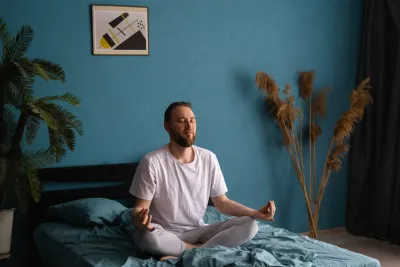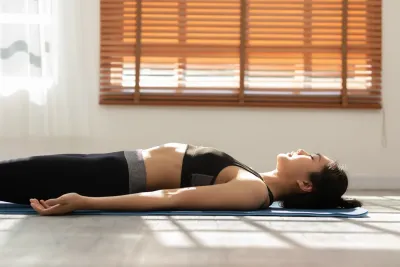Deep Breathing for Sleep: The Best Exercises to Relax Before Bed
Sleepme Editorial Team • Jan 05, 2023

Key Takeaways
- Breathing Basics: Deep breathing activates your body’s relaxation system, helping you release stress and transition more smoothly into sleep.
- Technique Matters: Simple practices like box breathing, the 4-7-8 method, or diaphragmatic breathing can quiet your mind and relax your body.
- Sleep Benefits: Making deep breathing a habit can help lower stress hormones, slow your heart rate, and set the stage for deeper, more restful sleep.
- Mindful Pairing: Pairing breathing with meditation, visualization, or calming sounds can enhance the effect and help you wind down even faster.
- Anytime Practice: Best of all, deep breathing goes with you anywhere—use it before bed to improve sleep or during the day to shake off stress.
Stress is a common experience caused by various factors such as work pressure, financial issues, mental health conditions, sleep disorders or problems, and relationship difficulties. Coping with stress can be challenging.
So, how do you combat stress? In some circumstances, you can address its external causes. For example, if your tax return stresses you out, you should file it as soon as possible to get the weight off your mind.
But stress can also be avoided by lifestyle changes such as increased exercise and a healthier diet.
One of the simplest ways to reduce stress is deep breathing. Unlike other lifestyle changes, deep breathing can be done anytime and anywhere.
Below, we've explored stress and how to reduce stress, focusing on the benefits of deep-breathing techniques and three easy exercises to get you started.
Enhance Your Sleep with Deep Breathing and Chilipad
Boost your morning energy with the right combination of deep breathing exercises and the comfort of a Chilipad bed cooling system.
What is Deep Breathing?
Deep breathing, otherwise known as diaphragmatic or abdominal breathing, is a form of breathing achieved by contracting the diaphragm, a muscle located under the lungs. In contrast, shallow breathing - something you're probably doing right now - happens without conscious effort.
That's not to say shallow, deep breathing techniques or “chest breathing” are always bad. After all, life would be very difficult if we had to concentrate in order to breathe.
But this low-effort type of breathing has its limitations. When we take shallow breaths, we don't completely fill our lungs with air, and the reduced oxygen intake can make us feel anxious or even feeling stressed.
Although it might feel strange to engage your lower abdomen while breathing, taking deep, diaphragm-focused breaths maximizes the amount of oxygen getting into your bloodstream, which produces important benefits, including relaxation, reduced blood pressure, and heart rate. [1]
Stress and Its Role in Disease Progression
Stress isn’t just in your head—it shows up in your body too. Beyond the racing thoughts and tension, stress can throw your immune system off balance, making it harder to fight off sickness and even making certain conditions worse. It’s wild (and a little unsettling) how closely our mood and our health are wired together.
According to a 2013 study, 60-80% of primary care visits are stress-related, yet only 3% of patients receive stress management help. [2]
Deep Breathing Benefits
Practicing deep breathing throughout the day is difficult, but setting aside time to concentrate on your air intake provides significant health benefits.
One of the greatest benefits, deep breathing helps reduced high blood pressure, which in turn lowers the risk of diseases like stroke, heart disease, and kidney failure. [3]
Research has shown that just 30 seconds of deep breathing can reduce systolic blood pressure, diastolic blood pressure, and pulse rate. [4]
Another positive effect of regular deep breathing is increased heart rate variability, which is a sign of good overall heart health. [5] A recent study found that regular deep breathing significantly improves HRV, which also boosts survival rates in heart disease patients suffering from diabetes.
The mental health benefits complement the physiological benefits of deep breathing. Using the diaphragm to breathe deeply can help you shake off the “fight or flight” response to stress and trigger the body's natural relaxation response, making you feel calmer.
Deep breathing before restful sleep and activating this relaxation response will help improve the quality of your rest, as stress regularly leads to difficulty sleeping.

Popular Deep Breathing Exercises
Practicing deep breathing is relatively easy, and there are different ways to get the diaphragm working and ensure enough oxygen intake.
A 10-minute meditation can lower heart rate and alleviate stress. Try one of the following breathing techniques as part of your wellness routine.
Basic Breathing Technique
Deep breathing involves drawing your shoulders back and breathing in slowly through the nose, drawing in enough air so that your belly rises before exhaling slowly through the mouth.
This can feel a little uncomfortable at first, as we're used to keeping our bellies flat when we want to control our posture. It's much easier to take deep breaths when you sit comfortably or even lie down.
Alternate Nostril Breathing
Also called Nadi Shodhana in yogic tradition, this technique involves gently guiding your breath through one nostril at a time. Using your fingers, you close one nostril to inhale through the other, then switch sides to exhale—and continue alternating in a steady rhythm.
You usually start with a deep, calming inhale, then move into this flow: close the right nostril to breathe in through the left, close the left to breathe out through the right, and repeat.
This simple practice is said to bring balance to both sides of the brain, quiet the mind, sharpen focus, and support relaxation while also improving lung function.
Diaphragmatic Breathing
Also called belly breathing, this technique focuses on using the diaphragm—the large muscle beneath your lungs—to take fuller, deeper breaths.
When you inhale, the diaphragm pulls downward, giving your lungs more room to expand. This creates a slow, deep breath instead of the shallow chest breathing we often default to.
As you exhale, the diaphragm relaxes and moves upward, helping push more air out of the lungs. The result is better oxygen flow throughout your body and a natural calming effect, since this type of breathing activates your relaxation response.
4-7-8 Breathing
This simple technique uses timed breaths to help you relax and slow down both body and mind. Inspired by a yogic practice called pranayama, it follows a clear rhythm:
- Inhale deeply through your nose for a count of 4
- Hold your breath for a count of 7
- Exhale slowly through your mouth for a count of 8
The steady counting keeps your attention anchored in the moment, making it easier to quiet racing thoughts while easing stress and tension.

Box Breathing Exercises
Box breathing, sometimes called square breathing, is one of the simplest yet most powerful tools for calming your system. The pattern is easy: deep inhale, hold your breath, exhale, hold your breath, each for the same count, creating a “square” rhythm.
It’s a favorite among athletes, military professionals, and anyone working under pressure because it sharpens focus, steadies emotions, and helps the body reset. Practicing it regularly can ease stress, boost clarity, and give you a reliable way to stay centered when life gets intense.
Rib-Stretch Breathing
Rib-stretch breathing is a deep breathing exercise that helps you really open up your ribcage. To get started, wrap your arms around your upper chest and place your palms flat against your sides. This helps you feel your ribcage expand and contract as you take deep breaths.
With each deep inhale, notice your ribs stretching out to make room for more air. As you exhale, feel the muscles around your ribs relax. This relaxation technique encourages fuller, deeper breaths and is especially good for loosening up your chest area and improving lung capacity.
Meditation Exercises
Meditation is a powerful way to bring your mind and body into harmony. By focusing your attention through simple techniques, you naturally ease into a state of calm and relaxation.
If you’re new to meditation or deep breathing, starting with beginner-friendly exercises can help you gently ease into the practice. These exercises guide you toward a peaceful, centered feeling that can minimize stress and create a calm foundation for your day or night.
Think of these meditation exercises as a gentle introduction to mindfulness that helps clear mental clutter and invites a sense of balance and tranquility.
Progressive Muscle Relaxation
Progressive muscle relaxation is a simple yet effective technique that combines deep breathing with slowly tightening and then releasing different muscle groups in your body. You start at one end—like your feet—and work your way up or down, focusing on each muscle group one at a time.
As you breathe in, gently tense the muscles in that area without straining, hold your breath for a few seconds, then breathe out as you fully relax them. This process helps you become more aware of tension in your body and promotes deep relaxation by releasing it.
For example, you might begin by tightening your feet, then move upward to your calves, thighs, stomach, shoulders, arms, and finally your face and neck. The combination of focused breathing and muscle relaxation helps lower stress, ease physical tension, and calm your mind.
Make Time for Deep Breathing
Adding deep breathing exercises to your daily routine can work wonders for both your mind and body. But it’s easy to forget to slow down and take those intentional breaths—that’s where setting an alarm or timer can be a game-changer.
Schedule a few short breaks throughout your day as reminders to pause and focus on your breath. When your timer goes off, resist the urge to hit snooze or rush away. Instead, take a moment for a few rounds of simple relaxation exercises. For example, breathe in slowly for a count of four, hold for four, then breathe out for four. Repeat this pattern several times, paying attention to the calming rhythm of your breath.
Note: Your parasympathetic nervous system is like the body's built-in calming switch. Its main job is to relax your sympathetic nervous system, which is responsible for the fight-or-flight stress response. When activated, the parasympathetic system helps slow your heart rate, lower blood pressure, and calm your mind, guiding your body into a state of rest and relaxation.
By making deep breathing a regular habit, you can reduce the impact of stress, lift your mood, and boost your overall well-being. So set that alarm, take a few minutes each day to breathe deeply, and let your mind and body thank you.
Final Thought
As we’ve explored different deep breathing exercises for reducing stress, it’s clear that each relaxation technique brings its own unique benefits. Whether improving sleep, boosting calmness, or sharpening focus, these simple practices offer easy ways to support your overall health and manage stress more effectively.
Whether you’re just starting out or want to deepen your existing routine, mindfulness-based breathing exercises are a powerful path toward greater relaxation and inner peace. Embracing these techniques can make a real difference in your well-being and help you navigate life with more calm and clarity.
Frequently asked questions
What Are Deep Breathing Exercises and Why Should I Try Them?
Deep breathing exercises are simple techniques that help you reset your body’s stress response. By intentionally slowing your breath, you can lower your heart rate, ease muscle tension, and improve sleep quality—basically, it is like giving your nervous system a software update.
How Quickly Can Deep Breathing Exercises Help Me Relax?
You can start feeling the calming effects of deep breathing in as little as one to three minutes. It is like hitting Ctrl+Alt+Delete on a stressful day—fast, efficient, and instantly refreshing.
What Are the Best Deep Breathing Techniques to Try?
Here are a few top breathing methods to kick-start your relaxation game:
- Box Breathing: Inhale for 4 seconds, hold for 4 seconds, exhale for 4 seconds, hold again for 4 seconds.
- 4-7-8 Breathing: Inhale for 4 seconds, hold for 7 seconds, exhale for 8 seconds.
- Diaphragmatic Breathing: Focus on breathing deeply into your belly rather than shallow chest breaths.
- Alternate Nostril Breathing: Inhale through one nostril, exhale through the other to balance the nervous system.
- Resonant Breathing: Breathe at a rate of 5 breaths per minute for maximum relaxation.
References
[1] Cleveland Clinic. (2019). Diaphragmatic Breathing Exercises & Techniques | Cleveland Clinic. Retrieved from Cleveland Clinic website. View Resource
[2] Nerurkar A, Bitton A, Davis RB, Phillips RS, Yeh G. When physicians counsel about stress: results of a national study. JAMA Intern Med. 2013 Jan 14;173(1):76-7. doi: 10.1001/2013.jamainternmed.480. PMID: 23403892; PMCID: PMC4286362.
[3] MORI, H., YAMAMOTO, H., KUWASHIMA, M., SAITO, S., UKAI, H., HIRAO, K., … UMEMURA, S. (2005). How Does Deep Breathing Affect Office Blood Pressure and Pulse Rate? Hypertension Research, 28(6), 499–504. View Study
[4] Russo M. A., Santarelli D. M., O’Rourke D. (2017). The physiological effects of slow breathing in the healthy human. Breathe 13 (4), 298–309. 10.1183/20734735.009817.
[5] Kulur, A. B., Haleagrahara, N., Adhikary, P., & Jeganathan, P. S. (2009). Effect of diaphragmatic breathing on heart rate variability in ischemic heart disease with diabetes. Arquivos brasileiros de cardiologia, 92(6), 423–463. View Study









